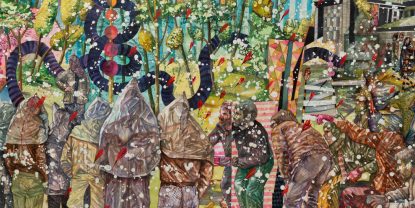Heading Utopia; Chapter 2: The Spring That Never Came
Behrang Samadzadegan
July 02 — July 21, 2021
“Heading Utopia; Chapter 2: The Spring that Never Came” is a series of paintings by Behrang Samadzadegan that, similar to a single narrative told in multiple volumes, is composed of visual, artistic, historical, and political citations, arranged in several seasons with no prolog or epilog, based on the artist’s personal interpretations. Here, there is no trace of faithfulness to painterly traditions and the artist does not show off the aesthetic aspects in his works. Narratives are the main material in these paintings; multifaceted narratives from history, politics, literature, and art, have come together with no apparent rhyme and no justification, in order to pose a question: is history and its visual or written documents valid? In other words, do they represent real events or are they the product of the mind of the writer and the visual documenter?
In this series, Behrang Samadzadegan does not seek to convey a particular message or establish a certain meaning: he is not walking on a path to verify or prove the truth. Different literary/artistic/political stories that have come down to us from different sources converge in these paintings and are depicted side by side in several layers. No single judgment or coherent conclusion comes to mind by observing the scenes. One follows a historical thread and then ends up in some other narrative. Wandering through the visual narratives as they combine with the questioning, inquiring mind of the artist has abstract and personal results. The interpenetrating behavior of colors and the aesthetic idea of the series are as unholy and flawed as the narratives that have shaped them.
“Heading Utopia; Chapter 2: The Spring that Never Came” is a struggle between incoherent narratives in a chaotic ambience. The series is the accumulation of various adaptations. Parts of it is taken from documentary photographs of Iran’s political history; specifically those taken between 1953 Iranian coup d’état and the 1979 Revolution, and all historic events that is tied with an idealistic hope. Other parts are borrowed from Persian classic romantic literature, such as “Khosrow and Shirin” and “Layla and Majnun” as well as stories that have come from overseas, such those of Franz Kafka, Paul Auster, and Haruki Murakami. The visual foundation of the works in an intermixture of compositions from Western art history and the visual-narrative structure of Persian miniature. The fruit of the coexistence of various citations and multiple adaptation is the death of the real account and the demise of aesthetics and the ideal.
